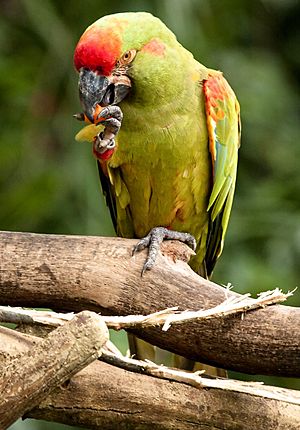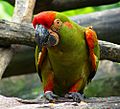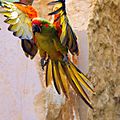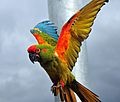Red-fronted macaw facts for kids
Quick facts for kids Red-fronted macaw |
|
|---|---|
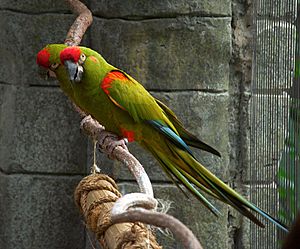 |
|
| At Tulsa Zoo, Oklahoma, USA | |
| Conservation status | |
| Scientific classification | |
| Genus: |
Ara
|
| Species: |
rubrogenys
|
 |
|
The red-fronted macaw (Ara rubrogenys) is a special type of parrot that lives only in a small, dry, mountainous part of Bolivia. When an animal lives only in one specific area, it is called endemic. This beautiful bird is a critically endangered species, which means there are very few left in the wild.
Even though they are rare in nature, red-fronted macaws have been successfully bred in zoos and special centers. Some people even keep them as pets. This macaw is also sometimes called Lafresnaye's macaw. It got this name from a French bird expert, Frédéric de Lafresnaye, who was one of the first people to describe this species.
Contents
What Does the Red-fronted Macaw Look Like?
The red-fronted macaw is a medium-sized parrot, usually about 55–60 cm (21.5–23.5 in) (22-24 inches) long. Most of its body is a bright green color.
It has some very noticeable red parts:
- A red forehead, right above its beak.
- A red patch of feathers over its ears.
- Bright red or orange feathers under its wings.
- Red feathers where its wings bend.
Around its eyes, the macaw has an area of pinkish skin that stretches all the way to its beak. Its main wing feathers, called primary feathers, are a pretty blue color.
Where Do Red-fronted Macaws Live?
The red-fronted macaw lives in a unique place in south-central Bolivia. This area is about 200 km (124 miles) west of the city of Santa Cruz. The climate there is like a semi-desert, meaning it's quite dry but not as extreme as a full desert.
The natural plants in this area are mostly cactuses (both large and small) and thorny trees and bushes. The weather is usually dry with cold nights and hot days. Rain doesn't fall often, but when it does, it comes in heavy storms.
This macaw is special because it's the only macaw species that lives in such a dry, semi-desert climate. Most macaws prefer to build their nests in holes inside large trees. However, in the red-fronted macaw's habitat, there aren't many very large trees. So, these clever birds make their nests in cracks and fissures on the faces of cliffs.
Why Are Red-fronted Macaws Endangered?
Sadly, the red-fronted macaw faces several threats that have made it critically endangered:
- Pet Trade: In the past, many of these birds were caught from the wild to be sold as pets. This greatly reduced their numbers.
- Farming Conflicts: Local farmers sometimes kill these macaws because the birds raid their crops, eating the food the farmers grow. This conflict makes it harder for the macaws to survive in their natural habitat.
Images for kids
See also
 In Spanish: Paraba frente roja para niños
In Spanish: Paraba frente roja para niños



